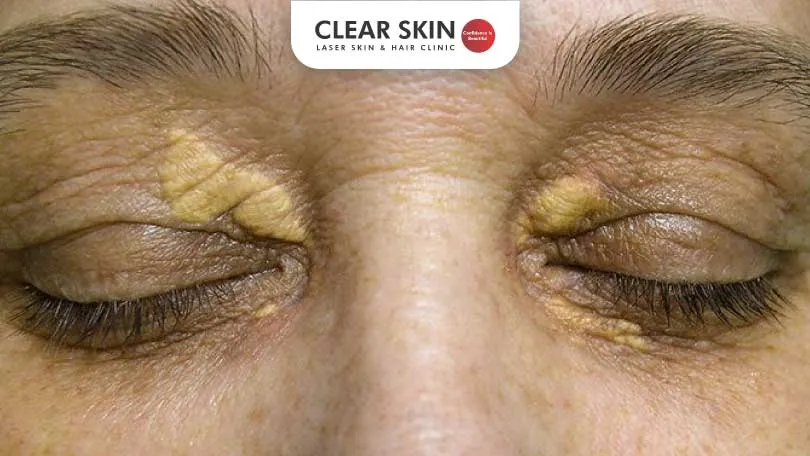Xanthelasma: Symptoms, Causes, Treatment and More

Written by Clear Skin Content Team | Medically Reviewed by Dr. Dhanraj Chavan on August 11, 2022

If you have noticed yellow, raised patches, on the inner corner of your eyelids, you may be suffering from xanthelasma. These patches are made from fatty cholesterol deposits that are settled under your skin.
Table Of Content
- Xanthelasma Treatment
- Causes of Xanthelasma Eyelid
- Types of Xanthelasma
- Detection and Symptoms
- Are You At Risk?
- Xanthelasma Treatment and Lifestyle Changes Needed
-
When to Visit Doctor for a Xanthelasma Treatment?
- Conclusion
Xanthelasma Treatment
They aren’t harmful, but there have been rare cases where they can signify underlying heart disease. You can always visit your dermatologist to know the best xanthelasma treatment for you.
This condition is quite rare, but if you have high levels of cholesterol or excessive fat cells in your blood you can experience xanthelasma on the upper eyelid. People who get it are usually suffering from obesity and are older. This condition is more common in women than men. If you are starting to see any xanthelasma symptoms, then you need to get your cholesterol levels checked.
Causes of Xanthelasma Eyelid
As mentioned before, the majority of the patients suffering from xanthelasma will have high cholesterol. However, in some cases, the patients may have normal cholesterol level.
Here are some other causes of xanthelasma palpebrarum growth:
- High levels of bad cholesterol and low levels of good cholesterol
- Inherited high cholesterol levels, it is also known as familial hypercholesterolemia
- Liver disease can raise cholesterol levels
- This condition usually affects people from Asia or the Mediterranian.
Types of Xanthelasma
Common Xanthelasma
It is demarcated by a yellowish collection of cholesterol that collects under the skin. It is usually found on the eyelids. A xanthoma is a larger and nodular lesion that assumes tumorous proportions and is different from xanthelasma. However, it is often classified as a subtype of xanthelasma.
Xanthoma Tuberosum
Tuberous Xanthoma is characterized by yellow lesions located over the joints.
Xanthoma Tendinosum
Tendinous Xanthoma is typically characterized by papules and nodules found in the tendons of the hands, feet, and heels. It is popularly associated with familial hypercholesterolemia.
Eruptive Xanthoma
Eruptive xanthoma is clinically characterized by small, yellowish-orange to reddish-brown papules that appear all over the body. It is associated with elevated amounts of triglycerides. Xanthoma diabeticorum is associated with severe diabetes.
Xanthoma Planum
Plane xanthoma is a type of xanthelasma that induces macules and plaques to spread over large areas of the body and are diffuse.
Palmar Xanthoma
In this condition, yellowish to orange plaques develop on the palms and flexural surfaces of the fingers. These flat macules could also be slightly elevated and often contain a centralized pale area; they may be localized or generalized.
They arise in the skin folds, especially the palmar creases. Palmar xanthoma is closely associated with hyperlipoproteinemia type III and type IIA and biliary cirrhosis. It is indicative of hypercholesterolemia.
Tuberoeruptive Xanthoma
Tuberoeruptive xanthoma is a type of eruptive xanthoma, clinically characterized by red papules and nodules that appear inflamed and tend to coalesce.
Xanthoma Disseminatum
This is a rare type of xanthoma, consisting of non-X histiocytosis on flexural surfaces, associated with diabetes insipidus. Hundreds of small yellowish-brown or reddish-brown bumps evenly spread on both sides of the face and trunk. They may particularly affect the armpits and groins. The small bumps may join together to form sheets of thickened skin.
Xanthoma Verrucous or Histiocytosis
This is associated with papilloma of the oral mucosa and skin, whereby the connective tissue under the epithelium contains histiocytes.
Diffuse Plane Xanthomatosis
It is associated with an abnormal antibody in the blood called a paraprotein. While lipid levels are normal, about 50% of the conditions have a malignancy of the blood such as multiple myeloma or leukemia. Large flat reddish-yellow plaques over the face, neck, chest, buttocks, and in the folds of the skin form.
Detection and Symptoms
Xanthelasma is commonly found on:
- One or both upper eyelids, especially near the nose
- One or both lower eyelids
The lesions appear as a yellow-to-orange patch or bump, ranging in size from 2–30 mm. Xanthelasma is flat-surfaced and has defined borders. Xanthelasma does not usually go away on its own and lesions tend to grow larger and increase in number.
Are You At Risk?
There are several conditions and factors which could make you susceptible to xanthelasma, such as:
- High levels of cholesterol or lipids in your blood; sometimes possible even with normal cholesterol levels
- Middle-aged or older individuals; Ages 15-73 are highly susceptible, with a peak in the 4th and 5th decade
- Female gender over male gender
- Arcus senilis of the cornea
- High blood pressure
- Obesity
- Chain-smoking
If any of these conditions and factors pertain to you and you notice symptoms, visit a doctor as soon as possible.
Xanthelasma can help predict the risk of myocardial infarction, ischemic heart disease, and severe atherosclerosis.
Xanthelasma Treatment and Lifestyle Changes Needed
Xanthelasma does not resolve by itself and requires medical attention and supervision. If left untreated, it will only spread further.
Apart from surgical methods, an individual’s lifestyle options play a major role. Diet is a major gamechanger.
The following measures should be incorporated into your diet:
- A healthy balance of vegetables, salads, cereals, and fish
- A minimization of saturated fats (found in meat, butter, other dairy produce, coconut oil, palm oil)
- Minimized intake of simple and refined sugars (found in soft drinks and confectionery)
- Reduction in calorie intake to lose weight if obese; regular exercise is advocated
- Medication has proved to be a very effective alternative to surgery. It can be administered in combination with it as well.
- Statins (HMG CoA reductase inhibitors), such as simvastatin and atorvastatin: Induce reduction in cholesterol production by the liver, thus resulting in lower LDL cholesterol levels, increase in HDL cholesterol, and mild reduction in triglycerides. May cause abnormalities if taken in heavy doses.
- Fibrates (bezafibrate): Reduce triglyceride production by the liver, therefore lowering triglycerides and increasing HDL cholesterol levels. May cause gastrointestinal side effects.
- Ezetimibe: If high doses of statins are poorly received or patients are at high risk, ezetimibe is prescribed. It reduces cholesterol absorption from the gut, lowering total and LDL cholesterol.
- Nicotinic acid: Lowers cholesterol, LDL cholesterol, and triglycerides, and increases HDL cholesterol. It Causes flushing if at least one gram is consumed a day for therapeutic purposes. Acipimox is a good alternative.
If you are worried about how Xanthelasma patches look on your eye, you can always consult with your dermatologist to get it removed. Your doctor will suggest the following treatments:
- Using medicine to dissolve the growth
- Use cryosurgery to freeze it off
- Laser therapy
- Surgery
- Using electrodesiccation, where an electric needle is used to remove xanthelasma
Even though these treatments have a success rate, you may encounter some side effects like:
- Change in complexion
- Scars
- Pigmentation
Also, these growths can come back, if you have inherited high cholesterol
When to Visit Doctor for a Xanthelasma Treatment?
A xanthelasma eyelid can be an indicator of an early cholesterol problem, and that plaque has started building in your blood vessels. If your cholesterol is not under control, then over time this plaque can clog your arteries, which will lead to a heart attack, stroke, or some other heart disease.
The xanthelasma growths can also be linked to other diseases like
- Diabetes
- High blood pressure
- Obesity
- Smoking
If you want to consult with a dermatologist about xanthelasma removal, then it’s best to see them the moment you notice the yellow patches. Also, don’t forget to consult your primary doctor about getting your blood pressure, cholesterol levels, and other heart risks checked.
Xanthelasma Removal Cost
Removing xanthelasma is a cosmetic process. This means that you have to check if the procedure is covered by your insurance; especially for procedures like surgery and cryotherapy. You must talk to your doctor and weigh your options carefully, before making a decision.
Xanthelasma is harmless, but you have to get it checked because it’s a sign of high cholesterol and underlying heart problems. Your doctor will evaluate you for underlying conditions and present you with viable treatment options that will help you eliminate this condition.
It is extremely important that you identify and treat your condition accurately. Clearskin clinics are equipped with safe and state-of-the-art infrastructure to assist you accordingly and provide you with a top-notch treatment.
Book an appointment with a Clearskin expert today!
Do You Know?
Roughly 250 Patients Are Treated
Everyday By These Dermatologists
(You are one click away from flawless skin)
Meet Our Dermatologist!
Conclusion
Xanthelasma, characterized by yellowish deposits around the eyes, can indicate underlying health issues. Early detection and treatment are crucial. Maintaining a healthy lifestyle and managing cholesterol levels can help prevent its occurrence. For effective treatment options and personalized care, consult the expert dermatologists at ClearSkin Clinic. Your journey to healthier skin starts with the right guidance.
Further Reading
IV Drip Therapy in Pune & PCMC: How It Works
Discover how to combat dry skin acne & achieve radiant skin. Expert skincare tips to hydrate & prevent breakouts. Visit Clear Skin Clinics Pune for solutions.
Dry Skin and Acne
Discover how to combat dry skin acne & achieve radiant skin. Expert skincare tips to hydrate & prevent breakouts. Visit Clear Skin Clinics Pune for solutions.
Why Acne Comes Back After Stopping Treatment? – Pune Insights
Discover why 20-50% of acne patients experience relapse after stopping treatment. Learn about hormonal factors, Pune’s monsoon impact, maintenance therapy importance, and Clear Skin Clinic’s proven prevention strategies.”,
Pune Acne Treatment Costs – What to Expect in 2026?
Complete guide to acne treatment costs in Pune 2026. Transparent pricing for chemical peels, laser treatment, and isotretinoin at Clear Skin Clinic
Have thoughts? Please let us know
We are committed not only to treating you, but also educating you.





